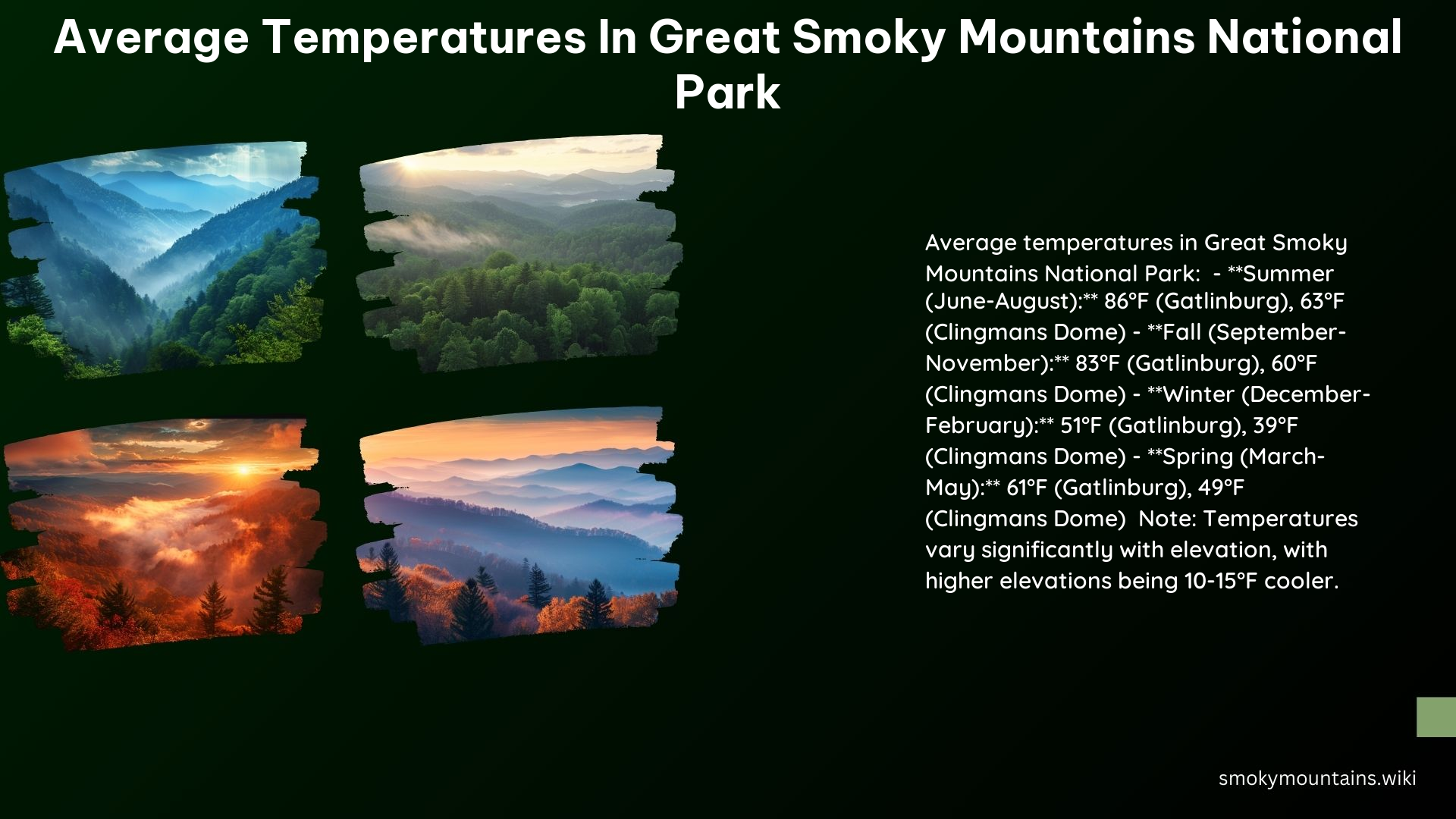The Great Smoky Mountains National Park is a stunning natural wonder that attracts millions of visitors each year. One of the key factors that draw people to this region is the diverse and ever-changing climate, which offers a wide range of temperatures throughout the year. In this comprehensive blog post, we’ll delve into the average temperatures you can expect to experience during your visit to the Great Smoky Mountains.
Seasonal Temperature Variations

Summer (June, July, August)
- Lower elevations: High 80s to low 90s (°F)
- Higher elevations: Mid-60s to low 70s
Fall (September, October, November)
- Lower elevations: High 70s to low 80s
- Higher elevations: Mid-50s to low 60s
Winter (December, January, February)
- Lower elevations: High 40s to low 50s
- Higher elevations: Mid-30s to low 40s
Spring (March, April, May)
- Lower elevations: High 60s to low 70s
- Higher elevations: Mid-40s to low 50s
Elevation Effects on Temperature

One of the most significant factors that influence the temperatures in the Great Smoky Mountains is the elevation. As you ascend the mountains, the temperatures can vary by up to 20 degrees Fahrenheit between the lower and higher elevations.
Seasonal Temperature Differences
The seasonal temperature differences in the Great Smoky Mountains are quite pronounced. During the summer, the lower elevations can experience high temperatures in the 80s and 90s, while the higher elevations remain much cooler, with temperatures in the 60s and 70s. In the winter, the opposite is true, with the lower elevations experiencing milder temperatures in the 40s and 50s, while the higher elevations can dip into the 30s and 40s.
Average Temperature in Winter
The winter months in the Great Smoky Mountains can be quite chilly, especially in the higher elevations. In the lower elevations, the average temperatures typically range from the high 40s to the low 50s. However, in the higher elevations, the average temperatures can drop to the mid-30s to low 40s.
Elevation Changes and Temperature
As mentioned earlier, the elevation plays a significant role in the temperatures within the Great Smoky Mountains. As a general rule, the higher you go, the cooler the temperatures will be. This is due to the fact that the air becomes thinner and less dense at higher elevations, which results in a decrease in temperature.
Precipitation
The Great Smoky Mountains are known for their high precipitation levels, with the most significant rainfall occurring during the spring and summer months. This can lead to increased humidity and the potential for thunderstorms, especially in the higher elevations.
Snowfall
While the lower elevations of the Great Smoky Mountains may only see occasional snowfall, the higher elevations can experience significant accumulations, particularly during the winter months of January through March.
Best Times to Visit
The most popular seasons to visit the Great Smoky Mountains are summer and fall. During the summer, visitors can enjoy the warm temperatures and outdoor activities, while the fall offers stunning foliage displays and milder temperatures. However, the spring and winter seasons also have their own unique charms, with the opportunity to experience the park in a different light.
Visitor Centers and Campgrounds
It’s important to note that some of the visitor centers and campgrounds within the Great Smoky Mountains National Park may have reduced hours or even close during the winter months, so it’s essential to check the park’s website or contact the park directly for the most up-to-date information.
Weather Forecast
If you’re planning a trip to the Great Smoky Mountains, be sure to check the weather forecast for the specific locations you’ll be visiting. The park’s website and other online resources offer detailed forecasts for areas like Gatlinburg, Townsend, and Cherokee, which can help you prepare for the conditions you’ll encounter.
Climate
The climate of the Great Smoky Mountains is characterized by high precipitation, especially in the higher elevations, and significant temperature variations between seasons and elevations. This diversity in weather patterns is what makes the park such a unique and captivating destination.
Drought Index
The Keetch-Byram Drought Index (KBDI) is a tool used to measure moisture deficiency and assess fire potential within the Great Smoky Mountains National Park. This information can be valuable for visitors planning outdoor activities during drier periods.
Weather Patterns
The weather patterns in the Great Smoky Mountains are influenced by a variety of factors, including the park’s latitude, nearby moisture sources, and the orientation of the mountains. Understanding these patterns can help visitors better prepare for the conditions they may encounter during their visit.
Temperature and Precipitation Data
If you’re interested in more detailed information on the temperature and precipitation averages for specific locations within the Great Smoky Mountains National Park, there are numerous resources available that provide this data.
Visitor Information
Regardless of the season, it’s important for visitors to the Great Smoky Mountains to be prepared for a wide range of weather conditions. Packing layers, bringing rain gear, and checking the forecast can help ensure a comfortable and enjoyable experience.
Road Status
The park’s website also provides up-to-date information on the status of roads within the Great Smoky Mountains National Park, which can be helpful for planning your visit and navigating the area.
Tourism Score
According to travel experts, the best time for warm-weather activities in the Great Smoky Mountains is from June to August, when the temperatures are at their highest and the park is in full bloom.
Cloud Cover
The Great Smoky Mountains experience partial cloud cover throughout the year, with the clearest month being October and the cloudiest month being January.
Sun and Moon Data
For those interested in planning their visit around the sun and moon positions, detailed data on these celestial events is available for the Great Smoky Mountains National Park.
Detailed Forecasts
In addition to the general weather information provided, in-depth forecasts are available for specific locations within the Great Smoky Mountains, allowing visitors to better prepare for the conditions they may encounter.
Weather and Climate Resources
If you’d like to delve deeper into the weather and climate patterns of the Great Smoky Mountains National Park, there are numerous resources available, including the park’s website, travel guides, and scientific publications.
References:
– https://travel.usnews.com/Great_Smoky_Mountains_National_Park_TN/When_To_Visit/
– https://www.nps.gov/grsm/planyourvisit/weather.htm
– https://smokymountains.com/park/blog/gsm-national-park-weather-months
– https://hikinginthesmokys.com/weather/
– https://weatherspark.com/y/150295/Average-Weather-in-Great-Smoky-Mountains-National-Park-Tennessee-United-States-Year-Round
